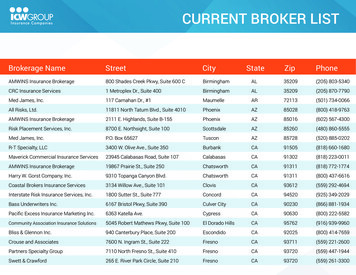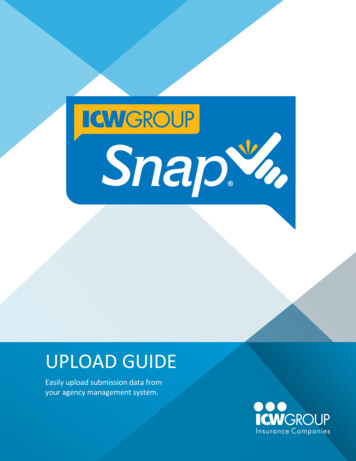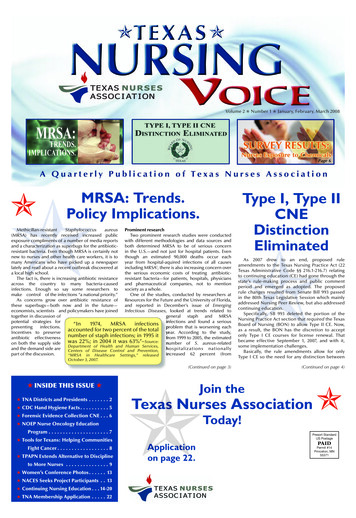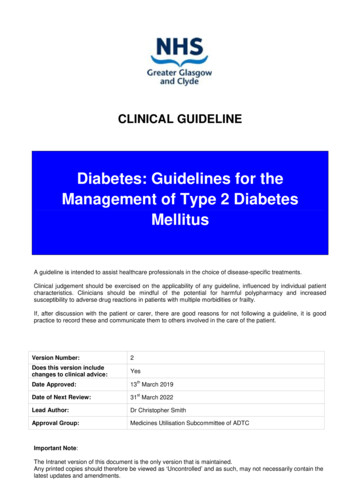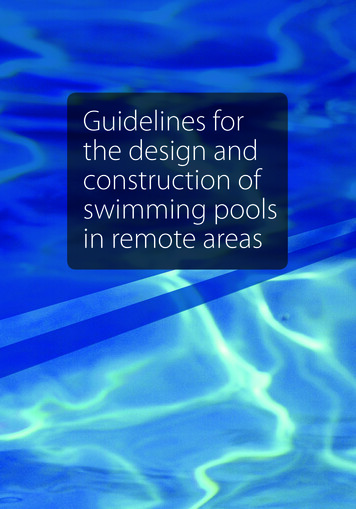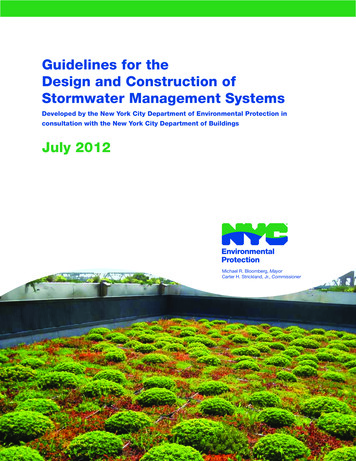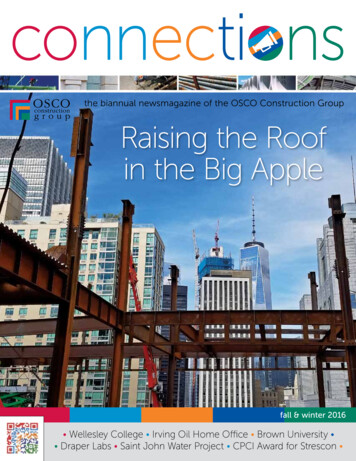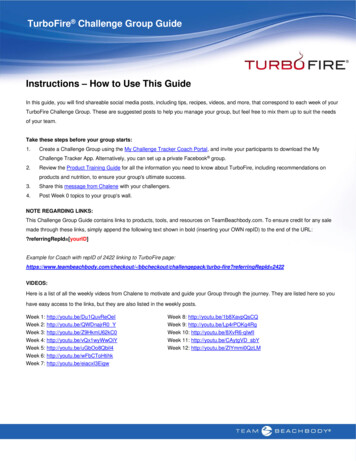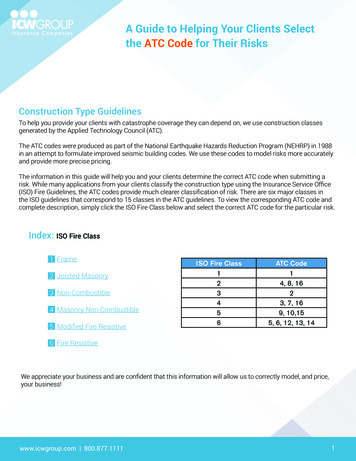
Transcription
A Guide to Helping Your Clients Selectthe ATC Code for Their RisksConstruction Type GuidelinesTo help you provide your clients with catastrophe coverage they can depend on, we use construction classesgenerated by the Applied Technology Council (ATC).The ATC codes were produced as part of the National Earthquake Hazards Reduction Program (NEHRP) in 1988in an attempt to formulate improved seismic building codes. We use these codes to model risks more accuratelyand provide more precise pricing.The information in this guide will help you and your clients determine the correct ATC code when submitting arisk. While many applications from your clients classify the construction type using the Insurance Service Office(ISO) Fire Guidelines, the ATC codes provide much clearer classification of risk. There are six major classes inthe ISO guidelines that correspond to 15 classes in the ATC guidelines. To view the corresponding ATC code andcomplete description, simply click the ISO Fire Class below and select the correct ATC code for the particular risk.Index: ISO Fire Class1 Frame2 Joisted Masonry3 Non-Combustible4 Masonry Non-Combustible5 Modified Fire ResistiveISO Fire Class123456ATC Code14, 8, 1623, 7, 169, 10,155, 6, 12, 13, 146 Fire ResistiveWe appreciate your business and are confident that this information will allow us to correctly model, and price,your business!www.icwgroup.com 800.877.11111
A Guide to Helping Your Clients Selectthe ATC Code for Their RisksWood Frame (ATC 1)DescriptionBuildings with walls constructed of 2x4” or 2x6” wood studs spaced at 16” covered on the outside with plywood,lap siding, or stucco and on the inside with gypsum board or lath and plaster. This is a very common form ofresidential construction. Well-constructed buildings of this type are typically earthquake resistant because ofthe high lateral force strength that the wood stud walls and plywood provides, and because most buildings arelightweight.Bolting the frame of the structure to its foundation can reduce the exposure of building damage. Unbolted buildingsmay slide off their foundations during a strong earthquake, causing significant damage. Anchoring the frame to thefoundation has proven to be the best means of protection against earthquake damage in frame structures. Mostbuildings constructed after 1949 are considered to be bolted to the foundation.Buildings constructed prior to 1949 may not be bolted to the foundation. Another common deficiency in olderwood frame buildings is inadequate strength in the cripple walls, walls enclosing the crawl space between theground surface and floor beams. A similar situation holds for the aboveground walls of a basement, or the wallsbelow floor level on a sloping site. These lowest level walls are often inadequate because of large openings,have no sheathing, or are sheathed only on one side. Structural failure often occurs with this type of olderconstruction.Wood Buildings (W)RaftersHorizontal sidingJoistsVertical wallframingWood stud light frame constructionwww.icwgroup.com 800.877.11112
A Guide to Helping Your Clients Selectthe ATC Code for Their RisksUnreinforced Masonry (ATC 4)DescriptionUnreinforced Masonry buildings (URM) include both unreinforcedbrick and unreinforced concrete block buildings. There is little or noembedded steel reinforcement in the masonry. The unreinforcedmasonry structural walls support the building weight and offer limitedresistance to earthquake forces.Many unreinforced masonry buildings in the United States are over100 years old. Unreinforced masonry buildings are usually four storiesor less. The framing for the floors and roof, whether of wood, steelor concrete, is supported by the walls. In California, building codeschanged in 1945, no longer allowing unreinforced masonry infill walls.Unreinforced Masonry (URM)Roof/floor span systemsBearing wall - four ormore wythes of brickShallowarched windowopeningsNote: For ATC 4, the building type would contain a structural frame.Reinforced Masonry (ATC 8)Horizontal reinforcement laidin mortarDescriptionReinforced masonry buildings are built of concrete block, brick orother masonry materials with steel reinforcing bars inserted intothe cells of the masonry and the cells filled with concrete. This isnot reinforced concrete construction, since the reinforcing is notan integral part of the masonry during the original construction; itis inserted and then filled after the walls are already constructed.This creates a monolithic wall, but unless the wall is also tied to thefoundation, it will not preclude the building shifting off the foundationduring an earthquake.Concrete infillNote: For ATC 8, the building type would contain a structural frame.Concrete Tilt-up (ATC 16)DescriptionThe concrete tilt-up wall is often used for large one or two storyindustrial or warehouse buildings. The concrete walls, which are castas panels on the building floor and then tilted into place, resist bothgravity loads (vertical) and earthquake forces. Additional or elevatedfloors usually have wood or steel frame. Some buildings may actuallybe classified as ATC 10 or 12. Buildings built prior to 1976 are mostvulnerable to damage. Buildings built after 1976 have stricter buildingcodes, with even better construction after 1997. In addition, buildingswith a wood joist roof would typically be classified as ISO 2, or ametal roof as ISO 4.www.icwgroup.com 800.877.1111Concrete Tilt-up Wall (PC1)RootframingElevated floorWall panels3
A Guide to Helping Your Clients Selectthe ATC Code for Their RisksLight Metal (ATC 2)DescriptionLight Metal buildings include buildings with exterior walls, floors, and roofs of non-combustible or slow-burning materials,building supports of non-combustible or slow-burning materials, and non-combustible or slow-burning roof decks onnon-combustible or slow-burning supports — regardless of the type of insulation on the roof surface.Structural Steel, Walls andRoof are Non Combustibleor Slow-Burningwww.icwgroup.com 800.877.11114
A Guide to Helping Your Clients Selectthe ATC Code for Their RisksUnreinforced Masonry (ATC 3)DescriptionUnreinforced Masonry buildings (URM) include both unreinforcedbrick and unreinforced concrete block buildings. There is little or noembedded steel reinforcement in the masonry. The unreinforcedmasonry structural walls support the building weight and offer limitedresistance to earthquake forces.Many unreinforced masonry buildings in the United States are over100 years old. Unreinforced masonry buildings are usually four storiesor less. The framing for the floors and roof, whether of wood, steelor concrete, is supported by the walls. In California, building codeschanged in 1945, no longer allowing unreinforced masonry infill walls.Unreinforced Masonry (URM)Roof/floor span systemsBearing wall - four ormore wythes of brickShallowarched windowopeningsNote: For ATC 3, the building type would not have a structuralframe.Reinforced Masonry (ATC 7)Horizontal reinforcement laidin mortarDescriptionReinforced masonry buildings are built of concrete block, brick orother masonry materials with steel reinforcing bars inserted intothe cells of the masonry and the cells filled with concrete. This isnot reinforced concrete construction, since the reinforcing is notan integral part of the masonry during the original construction; itis inserted and then filled after the walls are already constructed.This creates a monolithic wall, but unless the wall is also tied to thefoundation, it will not preclude the building shifting off the foundationduring an earthquake.Concrete infillNote: For ATC 7, the building type would not have a structuralframe.Concrete Tilt-up (ATC 16)DescriptionThe concrete tilt-up wall is often used for large one or two storyindustrial or warehouse buildings. The concrete walls, which are castas panels on the building floor and then tilted into place, resist bothgravity loads (vertical) and earthquake forces. Additional or elevatedfloors usually have wood or steel frame. Some buildings may actuallybe classified as ATC 10 or 12. Buildings built prior to 1976 are mostvulnerable to damage. Buildings built after 1976 have stricter buildingcodes, with even better construction after 1997. In addition, buildingswith a wood joist roof would typically be classified as ISO 2, or a metalroof as ISO 4.www.icwgroup.com 800.877.1111Concrete Tilt-up Wall (PC1)RootframingElevated floorWall panels5
A Guide to Helping Your Clients Selectthe ATC Code for Their RisksSteel Moment Frame (ATC 9 and 10)DescriptionSteel rectangular moment-resisting frame buildings have vertical columns and horizontal girders or beams of steel H sections.The floor delivers the weight of the building to the girders. The columns and girders support the total weight of the building.The columns and girders are rigidly connected together into rectangular frames. Horizontal earthquake forces are resisted bythe strength and ductility of the column/girder joints, and the bending strength of the members.Braced frames (ATC 9) use trussing to resist sideways forces on buildings. Trussing is formed by inserting diagonal structuralmembers into rectangular areas of a structural frame. Braced frames are typically classed as Single Diagonal and CrossBracing.There are also Knee Bracing, K Bracing, V Bracing and Inverted V Bracing. Cross Bracing and K Bracing are very rigid. Thebracing is often concealed by panels and it is not easy to tell a building has bracing from outside. Buildings with K Bracing aretypically classified as ATC 9, whereas ATC 10 does not have K Bracing.Concrete shearwallsGirders,beamsColumnsLong Span (ATC 15)This is generally a code associated with structures with suspended roofing or suspended walkways.www.icwgroup.com 800.877.11116
A Guide to Helping Your Clients Selectthe ATC Code for Their RisksReinforced Concrete Shear Wall with moment-resisting frame (ATC 5)DescriptionReinforced Concrete shear walls support vertical loads. Shearwall with moment-resisting frame is a dual system in whicha frame and shear wall are interconnected by the floor to actintegrally as one system by making use of each forte: flexibilityof frame and non-ductility of shear wall.RC Shear Wallwith momentresistingframe building.Reinforcedconcrete shearwalls aroundcentral core, i.e.central elevatorsand stairs.RC Shear Wall without frame (ATC 6, 12 and 13)Cast-in-place reinforced concrete walls support thebuilding weight.Roof/floordiaphragmsDistributedconcrete frameCurtainwallsInfillwallsConcrete Moment Frame buildingReinforced Concrete Frame Ductile (ATC 12) Nonductile (ATC 13)The concrete moment frame has vertical columns andhorizontal girders cast together to form rectangularconcrete frames, as shown below. The frames may beexposed or enclosed by curtain walls or a masonry veneer.Most concrete moment-frame buildings with nonductileframes have a limited capacity to resist large earthquakeforces. When deformed, the nonductile concrete momentframes have been badly damaged and lose their strength.www.icwgroup.com 800.877.1111The most spectacular major building collapses in theNorthridge Earthquake in 1994 were typically of reinforcedconcrete frame building designed and built prior to 1975.(It is also noted that some post 1975 parking garagescollapsed or were severely damaged.)Non-ductility results from1. wide spacing between ties,2. main bar splices all at the same location,3. insufficient shear reinforcement,4. insufficient tie anchorage,5. lack of continuous beam reinforcementthrough joints with columns, and6. inadequate reinforcing of joints.Ductile Concrete moment-frame buildings are much lesslikely to collapse in an earthquake. They are built withclosely spaced reinforcing and other details that give goodductility to the frame.These reinforcement details are concealed by theconcrete, therefore, it is difficult to tell whether a concreteframe is ductile or nonductile. In high seismic areas,concrete moment resisting frame buildings built afterabout 1976-1980 almost always have ductile frames. Inlow and moderate seismic areas, nonductile concreteframe buildings are allowed and are still built.7
A Guide to Helping Your Clients Selectthe ATC Code for Their RisksPrecast Concrete (other than Title-up) (ATC 14)DescriptionPrecast construction is characterized by roof and floor systems consisting of structural concrete T sections, structuraldouble T sections and hollow-core concrete slabs.The walls consist of load-bearing frame components (typically cross sections) and multi-story load-bearing panels.Curtain wall systems are characterized by pre-cast concrete panels, metal, glass or stone panels. The structural system ofa pre-cast building consists of pre-cast columns and beams.Precaste ConcreteRoof/floor span systems:1. Structural concrete T sections2. Structural double T sections3. Hollow-core concrete slabWall systems:4. Load-bearing framecomponents (cross)5. Multistory load-bearing panelsCurtain wall systems:6. Precast concrete panels7. Metal, glass, or stone panelsStructural systems:8. Precast column and beamswww.icwgroup.com 800.877.11118
the ISO guidelines that correspond to 15 classes in the ATC guidelines. To view the corresponding ATC code and complete description, simply click the ISO Fire Class below and select the correct ATC code for the particular risk. Index: ISO Fire Class 1 Frame 2 Joisted Masonry 3 Non-Combus
